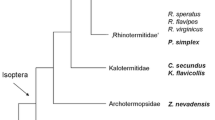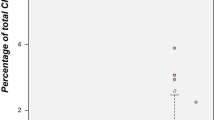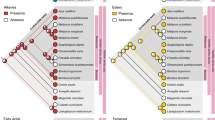Abstract
All individuals in social insect colonies benefit from being informed about the presence and fertility state of reproducers. This allows the established reproductive individuals to maintain their reproductive monopoly without the need for physical control, and the non-reproductive individuals to make appropriate reproductive choices. Here, we studied whether fertility signaling is responsible for the partitioning of reproduction in the ant Neoponera apicalis. This species forms small colonies from one single-mated queen, with workers establishing reproductive hierarchies when hopelessly queenless. Previous studies identified putative fertility signals, particularly the hydrocarbon 13-methylpentacosane (13-MeC25), and have shown that precise status discrimination based on these signals could be involved in the regulation of reproductive activities. Here, we extend these findings and reveal that all individuals, be they queens or workers, differ in their cuticular hydrocarbon profile according to fertility state. Proportions of 13-MeC25 were a strong predictor of an individual’s ovarian activity, and could, thus, advertise the established reproducer(s) in both queenright and queenless conditions. Furthermore, this compound might play a key role in the establishment of the reproductive hierarchy, since workers with low fertility at the onset of hierarchy formation already have relatively high amounts of 13-MeC25. Dyadic encounters showed that individuals with experimentally increased amounts of 13-MeC25 triggered less agonistic interactions from top rankers, in accord with them “advertising” higher status. Thus, these bioassays supported the use of 13-MeC25 by competing ants. This simple recognition system potentially allows permanent regulation of partitioning of reproduction in this species.


Similar content being viewed by others
References
Appleby MC (1983) The probability of linearity in hierarchies. Anim Behav 31:600–608
Bates D, Maechler M, Bolker B, Walker S (2013) lme4: Linear mixed-effects models using Eigen and S4. R package version 1.0-4. http://CRAN.R-project.org/package=lme4. Accessed 2 Oct 2013
Blacher P, Lecoutey E, Fresneau D, Nowbahari E (2010) Reproductive hierarchies and status discrimination in orphaned colonies of Pachycondyla apicalis ants. Anim Behav 79:99–105
Blomquist GJ (2010) Biosynthesis of cuticular hydrocarbons. In: Blomquist GJ, Bagnières A-G (eds) Insect hydrocarbons: biology, biochemistry, and chemical ecology. Cambridge University Press, Cambridge, pp 35–52
Bourke AFG (1988) Worker reproduction in the higher eusocial Hymenoptera. Q Rev Biol 63:291–311
Buczkowski G, Silverman J (2005) Context-dependent nestmate discrimination and the effect of action thresholds on exogenous cue recognition in the Argentine ant. Anim Behav 69:741–749
Cuvillier-Hot V, Lenoir A, Crewe R, Malosse C, Peeters C (2004) Fertility signalling and reproductive skew in queenless ants. Anim Behav 68:1209–1219
Dapporto L, Santini A, Dani FR, Turillazzi S (2007) Workers of a Polistes paper wasp detect the presence of their queen by chemical cues. Chem Senses 32:795–802
de Biseau J-C, Passera L, Daloze D, Aron S (2004) Ovarian activity correlates with extreme changes in cuticular hydrocarbon profile in the highly polygynous ant, Linepithema humile. J Insect Physiol 50:585–593
Delabie JHC, Mariano CSF, Mendes LF, Pompolo SG, Fresneau D (2008) Problemas apontados por estudos morfológicos, ecológicos e citogenéticos no gênero Pachycondyla na região Neotropical: o caso do complexo apicalis. In: Vilela EF, Santos IA, Schoereder JH, Neto JL, Serrão JE, Campos LAO (eds) Insetos sociais: da biologia à aplicação. Editora UVF, Viçosa, pp 197–222
Dietemann V, Peeters C (2000) Queen influence on the shift from trophic to reproductive eggs laid by workers of the ponerine ant Pachycondyla apicalis. Insect Soc 47:223–228
Dietemann V, Peeters C, Liebig J, Thivet V, Hölldobler B (2003) Cuticular hydrocarbons mediate discrimination of reproductives and nonreproductives in the ant Myrmecia gulosa. Proc Natl Acad Sci U S A 100:10341–10346
Endler A, Liebig J, Schmitt T, Parker JE, Jones GR, Schreier P, Hölldobler B (2004) Surface hydrocarbons of queen eggs regulate worker reproduction in a social insect. Proc Natl Acad Sci U S A 101:2945–2950
Fresneau D (1994) Biology and social behaviour of a Neotropical ponerine ant (Pachycondyla apicalis). Dissertation, Université Paris 13
Getty T (2006) Sexually selected signals are not similar to sports handicaps. Trends Ecol Evol 21:83–88
Grafen A (1990) Biological signals as handicaps. J Theor Biol 144:517–546
Guédot C, Millar JG, Horton DR, Landolt PJ (2009) Identification of a sex attractant pheromone for male winterform pear psylla, Cacopsylla pyricola. J Chem Ecol 35:1437–1447
Hammond RL, Keller L (2004) Conflict over male parentage in social insects. PLoS Biol 2:1472–1482
Hartfelder K (2000) Insect juvenile hormone: from “status quo” to high society. Braz J Med Biol Res 33:157–177
Hartmann A, d’Ettorre P, Jones GR, Heinze J (2005) Fertility signalling–the proximate mechanism of worker policing in a clonal ant. Naturwissenschaften 92:282–286
Heinze J, d’Ettorre P (2009) Honest and dishonest communication in social Hymenoptera. J Exp Biol 212:1775–1779
Heinze J, Stengl B, Sledge MF (2002) Worker rank, reproductive status and cuticular hydrocarbon signature in the ant, Pachycondyla cf. inversa. Behav Ecol Sociobiol 52:59–65
Holman L (2012) Costs and constraints conspire to produce honest signaling: insights from an ant queen pheromone. Evolution 66:2094–2105
Holman L, Jorgensen CG, Nielsen J, d’Ettorre P (2010) Identification of an ant queen pheromone regulating worker sterility. Proc R Soc Lond B Biol Sci 277:3793–3800
Howard RW (1993) Cuticular hydrocarbons and chemical communication. In: Stanley-Samuelson DW, Nelson DR (eds) Insect lipids, chemistry, biochemistry and biology. University of Nebraska Press, Lincoln, pp 177–226
Howard RW, Blomquist GJ (2005) Ecological, behavioral, and biochemical aspects of insect hydrocarbons. Annu Rev Entomol 50:371–393
Hsu Y, Earley RL, Wolf LL (2006) Modulation of aggressive behaviour by fighting experience: mechanisms and contest outcomes. Biol Rev 81:33–74
Keller L, Nonacs P (1993) The role of queen pheromones in social insects: queen control or queen signal? Anim Behav 45:787–794
Lamba S, Kazi YC, Deshpande S, Natesh M, Bhadra A, Gadagkar R (2007) A possible novel function of dominance behaviour in queen-less colonies of the primitively eusocial wasp Ropalidia marginata. Behav Process 74:351–356
Liebig J (2010) Hydrocarbon profiles indicate fertility and dominance status in ant, bee, and wasp colonies. In: Blomquist GJ, Bagnières A-G (eds) Insect hydrocarbons: biology, biochemistry, and chemical ecology. University Press Cambridge, Cambridge, pp 254–281
Liebig J, Peeters C, Hölldobler B (1999) Worker policing limits the number of reproductives in a ponerine ant. Proc R Soc Lond B Biol Sci 266:1865–1870
Liebig J, Peeters C, Oldham NJ, Markstädter C, Hölldobler B (2000) Are variations in cuticular hydrocarbons of queens and workers a reliable signal of fertility in the ant Harpegnathos saltator? Proc Natl Acad Sci U S A 97:4124–4131
Martin SJ, Drijfhout FP (2009) How reliable is the analysis of complex cuticular hydrocarbon profiles by multivariate statistical methods? J Chem Ecol 35:375–382
Martin SJ, Helanterä H, Drijfhout FP (2008) Colony-specific hydrocarbons identify nest mates in two species of Formica ant. J Chem Ecol 34:1072–1080
Maynard Smith J, Harper DGC (1995) Animal signals: models and terminology. J Theor Biol 177:305–311
Monnin T (2006) Chemical recognition of reproductive status in social insects. Ann Zool Fenn 43:515–530
Monnin T, Malosse C, Peeters C (1998) Solid-phase microextraction and cuticular hydrocarbon differences related to reproductive activity in queenless ant Dinoponera quadriceps. J Chem Ecol 24:473–490
Oliveira PS, Hölldobler B (1990) Dominance orders in the ponerine ant Pachycondyla apicalis (Hymenoptera, Formicidae). Behav Ecol Sociobiol 27:385–393
Ottoni EB (2000) EthoLog 2.2: a tool for the transcription and timing of behavior observation sessions. Behav Res Methods Instrum Comput 32:446–449
Peeters C, Liebig J (2009) Fertility signaling as a general mechanism of regulating reproductive division of labor in ants. In: Gadau J, Fewell J (eds) Organization of insect societies: from genome to socio-complexity). Harvard University Press, Cambridge, pp 220–242
R Core Team (2012) R: a language and environment for statistical computing. R Foundation for Statistical Computing, Vienna, Austria. http://www.R-project.org/. Accessed 18 June 2012
Ratnieks FLW, Foster KR, Wenseleers T (2006) Conflict resolution in insect societies. Annu Rev Entomol 51:581–608
Reeve HK, Jeanne RL (2003) From individual control to majority rule: extending transactional models of reproductive skew in animal societies. Proc R Soc Lond B Biol Sci 270:1041–1045
Reyment RA (1989) Compositional data analysis. Terra Nov. 1:29–34
Searcy WA, Nowicki S (2005) The evolution of animal communication: reliability and deception in signaling systems. Princeton University Press, Princeton
Smith AA, Hölldobler B, Liebig J (2008) Hydrocarbon signals explain the pattern of worker and egg policing in the ant Aphaenogaster cockerelli. J Chem Ecol 34:1275–1282
Smith AA, Hölldober B, Liebig J (2009) Cuticular hydrocarbons reliably identify cheaters and allow enforcement of altruism in a social insect. Curr Biol 19:78–81
Smith AA, Millar JG, Hanks LM, Suarez AV (2012) Experimental evidence that workers recognize reproductives through cuticular hydrocarbons in the ant Odontomachus brunneus. Behav Ecol Sociobiol 66:1267–1276
Számadó S (2011) The cost of honesty and the fallacy of the handicap principle. Anim Behav 81:3–10
Van Oystaeyen A, Oliveira RC, Holman L, van Zweden JS, Romero C, Oi CA, d’Ettorre P, Khalesi M, Billen J, Wackers F, Millar JG, Wenseleers T (2014) Conserved class of queen pheromones stops social insect workers from reproducing. Science 343:287–290
Wenseleers T, Ratnieks FLW (2006) Comparative analysis of worker reproduction and policing in eusocial Hymenoptera supports relatedness theory. Am Nat 168:E163–E179
Wenseleers T, Helanterä H, Hart A, Ratnieks FLW (2004) Worker reproduction and policing in insect societies: an ESS analysis. J Evol Biol 17:1035–1047
Wilson EO (1971) The insect societies. Harvard University Press, Cambridge
Wyatt TD (2014) Pheromones and animal behavior: chemical signals and signatures, 2nd edn. Cambridge University Press, Cambridge
Yagound B, Blacher P, Fresneau D, Poteaux C, Châline N (2014) Status discrimination through fertility signalling allows ants to regulate reproductive conflicts. Anim Behav 93:25–35
Zahavi A (1975) Mate selection–a selection for a handicap. J Theor Biol 53:205–214
Acknowledgments
We thank Paul Devienne for help during ant collection and the building of our experimental setup, Philippe Cerdan for logistical support in the field, Jocelyn Millar and Isabelle Bataille for advice with the synthesis of 13-MeC25, and Margot Perez for statistical guidance. Two anonymous referees provided helpful comments on the manuscript. This study was supported by the Fundação de Amparo à Pesquisa do Estado da Bahia/Conselho Nacional de Desenvolvimento Científico e Tecnológico (PNX0011/2009 PRONEX).
Author information
Authors and Affiliations
Corresponding author
Electronic supplementary material
Below is the link to the electronic supplementary material.
ESM 1
(DOCX 15 kb)
Rights and permissions
About this article
Cite this article
Yagound, B., Gouttefarde, R., Leroy, C. et al. Fertility Signaling and Partitioning of Reproduction in the Ant Neoponera apicalis . J Chem Ecol 41, 557–566 (2015). https://doi.org/10.1007/s10886-015-0591-9
Received:
Revised:
Accepted:
Published:
Issue Date:
DOI: https://doi.org/10.1007/s10886-015-0591-9




